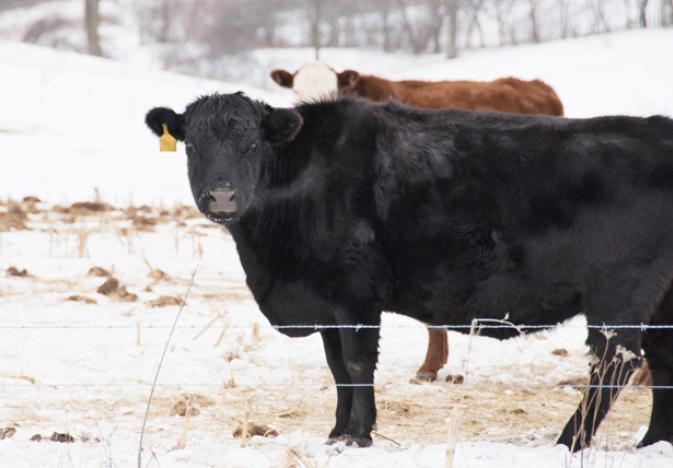Simple Solutions to Building Cow-Calf Producer Profitability
As we venture further into the new year, cattlemen and their animals are getting hit hard with extreme weather conditions, including large amounts of snow and some of the coldest temperatures we’ve seen in decades. The number-one concern at this time is almost certainly animal welfare — but many are also thinking about what they can do to ensure good returns, despite having to feed low-quality forages to their herd over the next several months.
 When it comes to enhancing rumen function, improving fiber digestibility and getting more out of available forages, producers want a straightforward solution to keeping cows in good condition and developing a healthy calf crop. Regarding rumen bacteria, cattle really need extra protein and carbohydrates to maintain good digestion and receive the full benefits of consumed forage. The additional protein and carbohydrates that can be delivered through self-fed supplements are essential to this process.
When it comes to enhancing rumen function, improving fiber digestibility and getting more out of available forages, producers want a straightforward solution to keeping cows in good condition and developing a healthy calf crop. Regarding rumen bacteria, cattle really need extra protein and carbohydrates to maintain good digestion and receive the full benefits of consumed forage. The additional protein and carbohydrates that can be delivered through self-fed supplements are essential to this process.
Additionally, mineral intake often declines at this time of year due to changes in feeding situations, so feeding a supplement that combines protein, carbohydrates and mineral delivery is helpful. Our research shows that when cattle are provided with CRYSTALYX® Brand Supplements, the result is often 10–15 percent better utilization of forage — similar to getting an extra five to seven bales of hay for every 50 bales purchased. Talk about an easy way to save money, time and labor.
The significance of monitoring body condition score (BCS)
A cow must be in good body condition before she can be successfully bred again. Current data suggests that if cows are somewhat thin (e.g., a 3 to 4 body condition score, on a scale of 1 to 9), they’re only going to become pregnant around 80 percent of the time.
By adding another 80 to 100 pounds of body weight, we will see body conditions improve to a BCS of 5 or 6. As a result, conception rates will increase from around 80 percent to 90–95 percent. Maintaining good body condition in a 50-cow herd can have effects similar to adding five or six extra calves.
BCS should be evaluated at least three times per year:
1. Prior to calving to provide a baseline (mid- to late-gestation, depending on whether you’re a fall- or spring-calving herd)
2. Prior to breeding, because BCS will impact conception rate
3. During mid-winter (February or March) to assess how animals are faring
The role of reproductive records in calculating return on investment (ROI)
Making money in the beef industry equates to pounds of calves sold. Tracking basic reproductive information is very useful in assessing ROI. Pregnancy rates are the most important element, but there’s a big difference between seeing a 90-percent pregnancy rate over a three-month period and a 90-percent pregnancy rate over a six-month period.
It’s wise to keep detailed records of calving dates and to group them into 21-day periods that match up with the estrus cycle of your cows. The more animals born early in a defined calving season, the more money producers will make; it’s just simple biology — calves that are born in the second round or conceived on the second heat are going to be 42 pounds lighter than their herd-mates who were born one cycle earlier.
Using current market prices, the 42-pound difference in a calf born one cycle late equates to about $60–65 USD. Clearly, every calf that could be born one or two cycles earlier starts to add up significantly. You can easily increase a cow’s income potential by more than $100 simply by having her calve early in the season, rather than two or three months out.
The CRYSTALYX BCS app
Since we see our own cattle so often, we can easily miss any subtle new changes — and extra steps would be required in order to access and maintain a paper log or spreadsheet. Fortunately, the CRYSTALYX beef cow body condition scoring app greatly simplifies this process. This app, which can be downloaded to your smartphone, will help you maintain readily accessible photo records and notes about your herd.
Within the app, you can easily compare your images to the included BCS reference photos in order to assign a body condition score before inputting ear tag and pasture location — it’s as simple as that! When you need to assess a particular animal in the future, instead of having to rely on your memory or dig up a spreadsheet, you will have more exact details and photo evidence directly on hand to guide you through any necessary changes.
For those keeping track of a group of animals, the app can also calculate averages so you can see how things are changing. Additionally, all of the information stored on the app is exportable, so if you want to maintain a body condition spreadsheet to tie in with your other reproductive records, you can easily keep a paper trail.
Increasing profitability doesn’t have to be a chore. Let CRYSTALYX Brand Supplements and our handy BCS app take some of the guesswork out of the equation. Contact your local dealer for more information.
SOURCE: drovers.com